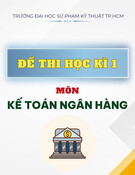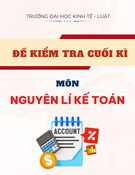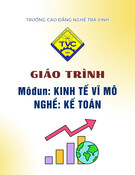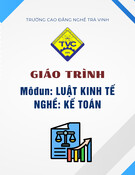Vũ Quốc Thông 10/16/2014
HO CHI MINH CITY OPEN UNIVERSITY ACCOUNTING – AUDITING FACULTY ACCOUNTING INFORMATION SYSTEM
ACCOUNTING RELATED PROCESSES
Lecturer: Vũ Quốc Thông
Chapter 4
Learning Objectives
Describe
the basic business
activities
and related information processing operations performed in the related accounting cycle.
Discuss the key decisions that need to be made in the related accounting cycle, and identify the information needed to make those decisions.
Identify major threats in the related accounting cycle, and evaluate the adequacy of various control procedures for dealing with those threats.
4-2
1
Vũ Quốc Thông 10/16/2014
The Revenue Cycle: Sales to Cash Collections
4-3
The Revenue Cycle
4-4
2
Vũ Quốc Thông 10/16/2014
The Revenue Cycle
Provides goods and services to customers
Primary Objective (P-P-P): Provide the right product In the right place At the right time for the right price
4-5
Collects cash in payment for those sales
Revenue Cycle Activities
2. Shipping
1. Sales order entry
3. Billing
4-6
4. Cash collections
3
Vũ Quốc Thông 10/16/2014
Sales Order Entry
1. Take order
3. Check inventory availability
4-7
2. Check and approve credit
Sales Order Threats
Invalid orders
Incomplete/inaccurate orders
Uncollectible accounts
Loss of customers
4-8
Stock-out or excess inventory
4
Vũ Quốc Thông 10/16/2014
Sales Order Entry Controls
Restriction of access to
master data
Perpetual inventory control system
Digital signatures or written signatures
Credit limits
Use of bar-codes or RFID
Training
Specific authorization to approve sales to new customers or sales that exceed a customer’s credit limit
Sales forecasts and activity
Periodic physical counts of inventory
Aging of accounts
receivable
reports
4-9
CRM systems, self-help Web sites, and proper evaluation of customer service ratings
Shipping
1. Picking and packing the order
4-10
2. Shipping the order
5
Vũ Quốc Thông 10/16/2014
Shipping Threats
Picking the wrong items or the wrong quantity
Shipping errors (delay or failure to ship, wrong
Theft of inventory
4-11
quantities, wrong items, wrong addresses, duplication)
Shipping Controls
Bar-code and RFID
technology
Reconciliation of picking lists to sales order details
Restriction of physical access
Reconciliation of
to inventory
shipping documents with sales orders, picking lists, and packing slips
Documentation of all inventory transfers
RFID and bar-code
technology
Data entry via bar-code scanners and RFID
Periodic physical counts of
inventory and reconciliation to recorded quantities
Use RFID systems to identify delays
4-12
Configuration of ERP system to prevent duplicate shipments
6
Vũ Quốc Thông 10/16/2014
Billing
1.
Invoicing
4-13
2. Updating accounts receivable
Billing Threats
Billing errors
Failure to bill
Posting errors in accounts receivable
4-14
Inaccurate or invalid credit memos
7
Vũ Quốc Thông 10/16/2014
Billing Controls
Separation of billing and Data entry controls shipping functions Mailing of monthly Reconciliation of statements to customers
Reconciliation of
invoices with sales orders, picking tickets, and shipping documents subsidiary accounts to general ledger
Configuration of system to automatically enter pricing data
Segregation of duties of
4-15
Restriction of access to pricing master data credit memo authorization from both sales order entry and customer account maintenance
Cash Collections Threats
2. Cash flow problems
4-16
1. Theft of cash
8
Vũ Quốc Thông 10/16/2014
Cash Collection Controls
Separation of cash handling function from accounts
receivable and credit functions
Regular reconciliation of bank account with recorded amounts by someone independent of cash collections procedures
Having two people open all mail likely to contain customer payments
Daily deposit of all cash receipts
Use of cash registers
4-17
Cash flow budgets
The Expenditure Cycle: Purchasing to Cash Disbursements
4-18
9
Vũ Quốc Thông 10/16/2014
The Expenditure Cycle
4-19
The Expenditure Cycle
Purchasing and payment of Goods and services
Activities and information processing related to:
Primary objective:
4-20
Minimize the total cost of acquiring and maintaining inventories, supplies, and the various services the organization needs to function
10
Vũ Quốc Thông 10/16/2014
Expenditure Cycle Activities
2. Receiving materials, supplies, and services
1. Ordering materials, supplies, and services
3. Approving supplier invoices
4-21
4. Cash disbursements
Ordering Threats
Inaccurate inventory records
Purchasing items not needed
Purchasing at inflated prices
Purchasing goods of inferior quality
Unreliable suppliers
4-22
Purchasing from unauthorized suppliers
11
Vũ Quốc Thông 10/16/2014
Ordering Controls
Periodic physical counts of inventory
Bar coding or RFID tags
Perpetual inventory system
Centralized purchasing function
Review and approval of purchase requisitions
Price lists
Competitive bidding
Budgets
4-23
Purchasing only from approved suppliers
Receiving Threats
Mistakes in counting
Accepting unordered items
Verifying receipt of services
4-24
Theft of inventory
12
Vũ Quốc Thông 10/16/2014
Receiving Controls
Budgetary controls
Requiring existence of approved purchase order prior to accepting any delivery
Restriction of physical access to inventory
Do not inform receiving
employees about quantity ordered
Require receiving employees to
Documentation of all transfers of inventory between receiving and inventory employees
sign receiving report
Document transfer of goods to
inventory
Periodic physical counts of inventory and reconciliation to recorded quantities
Use of bar-codes and RFID tags
Segregation of duties:
4-25
custody of inventory versus receiving
Invoice Processing
Non-Voucher
Each approved invoice is posted to individual supplier records in the accounts payable file and is then stored in an open-invoice file.
When a check is written to pay for an invoice, the voucher package is removed from the open-invoice file, the invoice is marked paid, and then the voucher package is stored in the paid-invoice file.
Voucher
invoice is approved for payment.
Disbursement voucher is also created when a supplier
4-26
Identifies the supplier, lists the outstanding invoices, and indicates the net amount to be paid after deducting any applicable discounts and allowances.
13
Vũ Quốc Thông 10/16/2014
Advantages of Voucher System
1. Reduce number of checks
2. Can utilize pre-sequential-numbered voucher control
4-27
3. Allows for separation of invoice approval from invoice payment
Approving Invoices Threats
Errors in supplier invoices
4-28
Mistakes in posting to accounts payable
14
Vũ Quốc Thông 10/16/2014
Approving Invoices Controls
Verification of invoice accuracy
Evaluated receipt settlement
Requiring detailed receipts for procurement card purchases
Match PO with receiving report
Restriction of access to supplier master data
Verification of freight bill and use of approved delivery channels
Data entry edit controls
4-29
Reconciliation of detailed
accounts payable records with the general ledger control account
Cash Disbursement Threats
payment
Failure to take advantage of discounts for prompt
Paying for items not received
Duplicate payments
Theft of cash
Check alteration
4-30
Cash flow problems
15
Vũ Quốc Thông 10/16/2014
Cash Disbursement Controls
Filing of invoices by due date for discounts
Cash flow budgets
Requiring that all supplier invoices be matched to supporting documents that are acknowledged by both receiving and inventory control
Budgets (for services)
Requiring receipts for travel expenses
Requiring a complete voucher package for all payments
Policy to pay only from original copies of supplier invoices
Cancelling all supporting documents when payment is made
4-31
More on reading and practice
Reading on textbook
Chapter 12 (p. 350 – 370) Chapter 13 (p. 390 – 410) Doing homework on paper
Question 12.2 (p. 379) & Question 13.2 (p. 415)
Problem solving
Discussion questions
Problem 12.11 (p. 383) & Problem 13.4 (p. 417, 418)
4-32
Chapter quiz (focus on relevant parts of the lecture)
Quiz of chapter 12 (p.378) Quiz of chapter 13 (p. 413, 414)
16





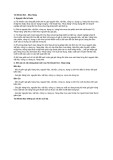

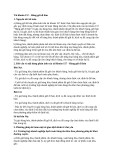

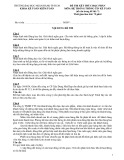
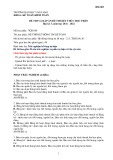

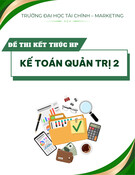
![Đề thi Kế toán ngân hàng kết thúc học phần: Tổng hợp [Năm]](https://cdn.tailieu.vn/images/document/thumbnail/2025/20251014/embemuadong09/135x160/19181760426829.jpg)


